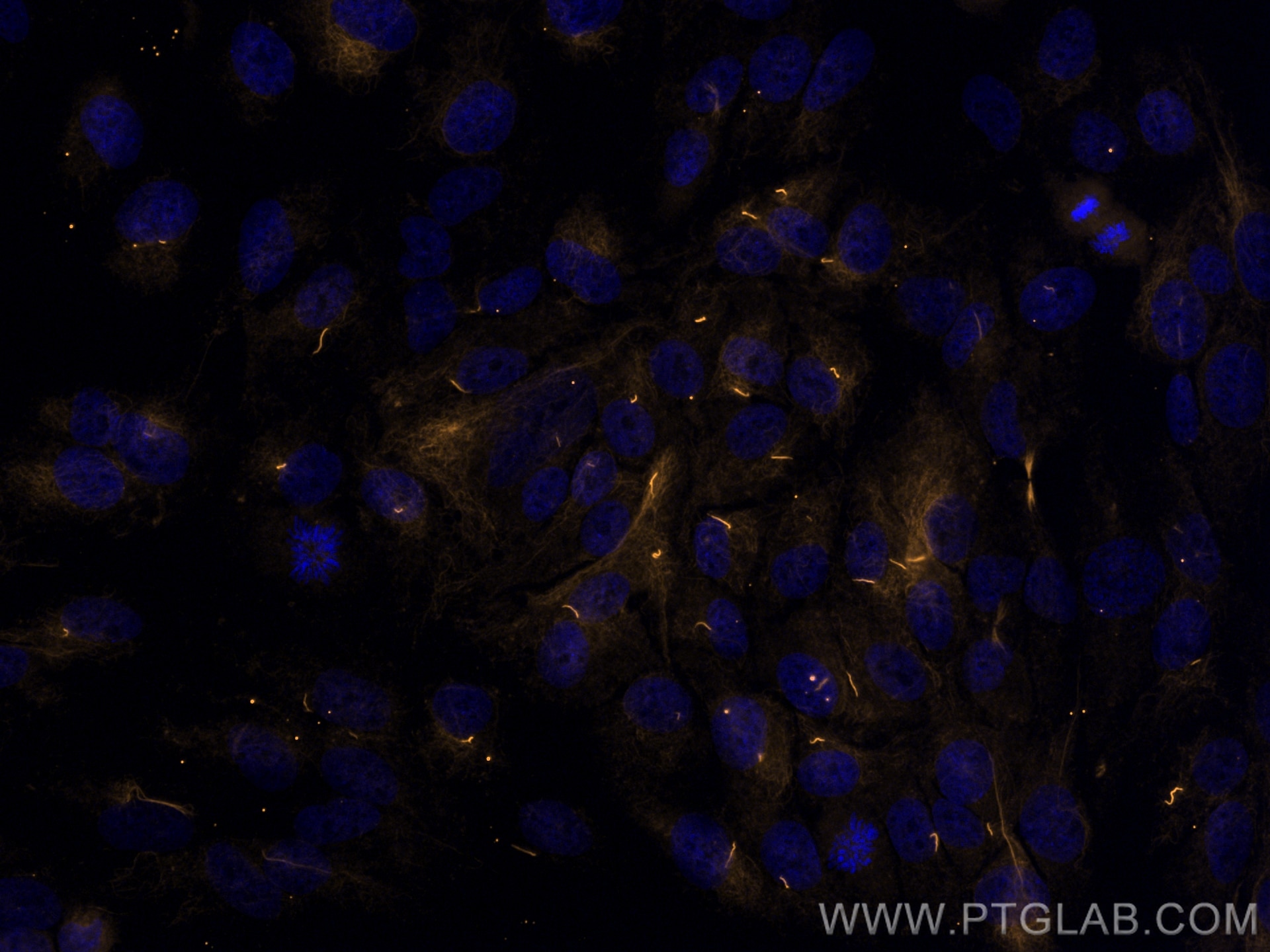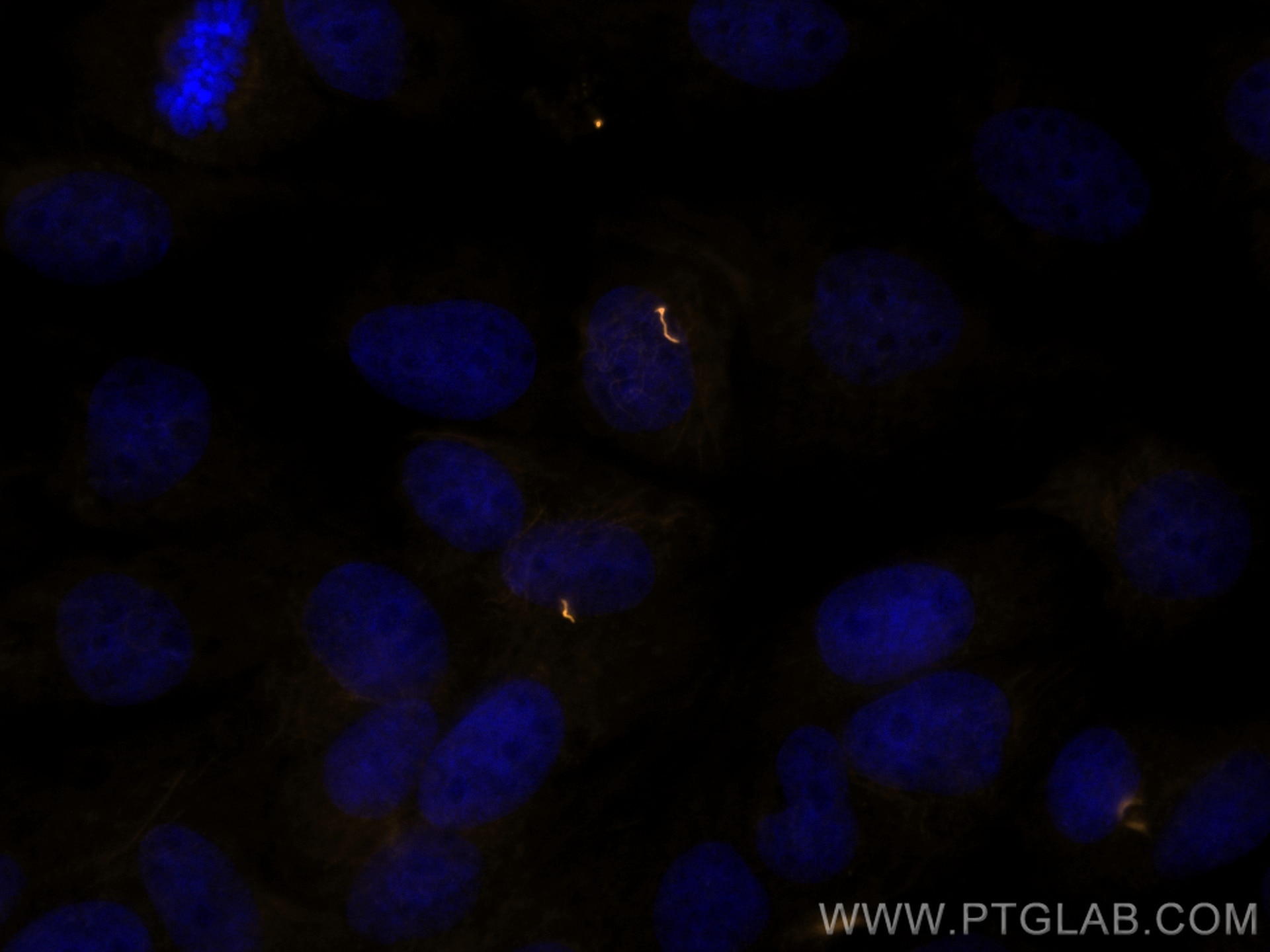Anticorps Monoclonal anti-Acetyl-Tubulin (Lys40)
Acetyl-Tubulin (Lys40) Monoclonal Antibody for IF/ICC
Hôte / Isotype
Mouse / IgG1
Réactivité testée
canin, Humain, porc, rat, souris
Applications
IF/ICC
Conjugaison
CoraLite®555 Fluorescent Dye
CloneNo.
7E5H8
N° de cat : CL555-66200
Synonymes
Galerie de données de validation
Applications testées
| Résultats positifs en IF/ICC | cellules MDCK, cellules hTERT-RPE1 |
Dilution recommandée
| Application | Dilution |
|---|---|
| Immunofluorescence (IF)/ICC | IF/ICC : 1:50-1:500 |
| It is recommended that this reagent should be titrated in each testing system to obtain optimal results. | |
| Sample-dependent, check data in validation data gallery | |
Informations sur le produit
CL555-66200 cible Acetyl-Tubulin (Lys40) dans les applications de IF/ICC et montre une réactivité avec des échantillons canin, Humain, porc, rat, souris
| Réactivité | canin, Humain, porc, rat, souris |
| Hôte / Isotype | Mouse / IgG1 |
| Clonalité | Monoclonal |
| Type | Anticorps |
| Immunogène | Peptide |
| Nom complet | tubulin, alpha 1a |
| Masse moléculaire calculée | 52 kDa |
| Poids moléculaire observé | 50-55 kDa |
| Numéro d’acquisition GenBank | NM_006009 |
| Symbole du gène | Alpha Tubulin |
| Identification du gène (NCBI) | 7846 |
| Conjugaison | CoraLite®555 Fluorescent Dye |
| Excitation/Emission maxima wavelengths | 557 nm / 570 nm |
| Forme | Liquide |
| Méthode de purification | Purification par protéine G |
| Tampon de stockage | PBS with 50% glycerol, 0.05% Proclin300, 0.5% BSA |
| Conditions de stockage | Stocker à -20 °C. Éviter toute exposition à la lumière. Stable pendant un an après l'expédition. L'aliquotage n'est pas nécessaire pour le stockage à -20oC Les 20ul contiennent 0,1% de BSA. |
Informations générales
What is the molecular weight of acetyl-α-tubulin?
The molecular weight of acetylated tubulin is 52 kD.
Where does the acetylation of Lys 40 occur?
This acetylation occurs inside the microtubule lumen by the α-tubulin acetyltransferase 1 (αTAT1) (PMID: 29207274).
How can acetylation be reversed?
Acetylation of Lys 40 can be reversed by deacetylase 6 (HDAC6), which is mostly cytoplasmic that also deacetylates Hsp90, and sirtuin 2 (SIRT2), which also mainly cytoplasmic and uses NAD as a coenzyme. Unlike HDAC6, SIRT uses both polymerized and soluble tubulin as substrates. Deacetylases are believed to be more active on soluble tubulin, while acetylases function preferentially on stable polymers (PMIDs: 29207274, 30079247, 19185337).
What is the function of acetylation?
Acetylation is a conserved post-translational modification of alpha tubulin at Lys 40 during tubulin assembly, and it correlates to increased microtubule stability and intracellular transport (PMIDs: 29207274, 30079247, 20940043).
Is acetylation of α-tubulin strictly associated with stable microtubules?
Not necessarily, as acetylation can have other effects on microtubule subpopulations (PMID 20940043).
Is ac-tubulin found only in cilia?
Acetylated-α-tubulin is located in cytoplasmic tubulin as well as in cilia; therefore, it is not strictly region-specific (PMID: 30079247).
What are the cellular effects of tubulin acetylation?
Microtubule acetylation seems to provide a critical role in neuronal development and function, and while its effect on cancer cells remains unclear, it has been shown that decreased acetylated α-tubulin impairs neuronal cell line migration. The post-translational modification may also help regulate organelle-independent signalling throughout the cell, supporting the notion of a microtubule network serving as a coordinator of cellular signaling (PMIDs: 29207274, 25503560, 20940043, 19185337).
Protocole
| Product Specific Protocols | |
|---|---|
| IF protocol for CL555 Acetyl-Tubulin (Lys40) antibody CL555-66200 | Download protocol |
| Standard Protocols | |
|---|---|
| Click here to view our Standard Protocols |



